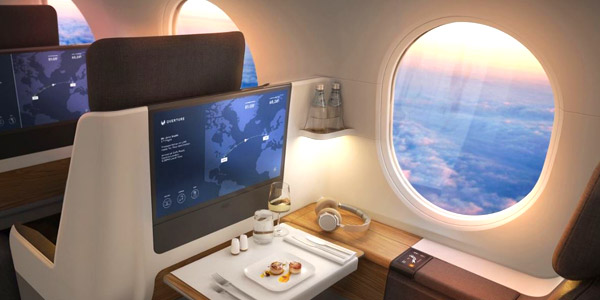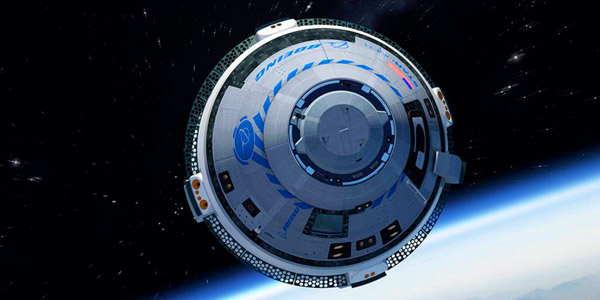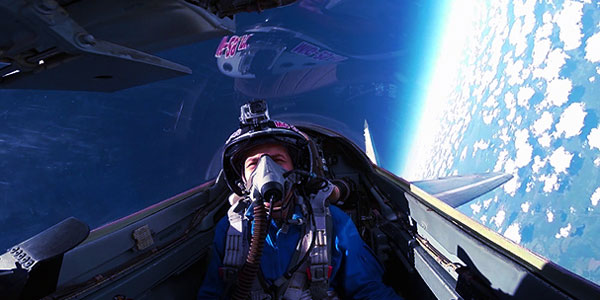|
OPINION Why space tourism is an oxymoron for the cash-strapped, but...
JUMP TO Current column 
Boom's supersonic 50-passenger Overture may be one way to escape at 60,000ft while flying Seattle to Tokyo in just over four hours. This net-zero carbon emission aircraft has been pre-ordered by United and Japan Air Lines. SPACE Tourism is as close to an oxymoron as you can get. Tourism carries connotations of mass travel, a herd following quality devoid of discrimination or independent savour. The term conjures up flag-waving tour groups and gold-capped-teeth captured for posterity by flashing cameras. In the 1980s a distinction began to be drawn by many, keenly emphasised by the legendary Harold Evans, then editing an American travel magazine, between indiscriminate tourists and people who moved about independently, armed with knowledge, taste, and well padded wallets. That new breed had always existed but found fresh definition, as the traveller. There is a significant difference between the traveller and the tourist. It is the difference between 600-thread-count linen, sipping 2009 Chateau Lafleur, and Bt600 digs in Bangkok with fleas, getting fleeced. In travel trade parlance this super category has long been wooed as the FIT (variously, foreign independent traveller in the US, fully independent traveller, or frequent independent traveller). Take your pick. They all mean the same thing. The traveller does all the heavy lifting on trip choice, planning, and price, though he may consult or book with an agent. Send us your Feedback / Letter to the Editor After billionaires Richard Branson and Jeff Bezos roared off to briefly graze the edge of space, tongues have wagged over the prospects of space tourism. With tickets in the range of US$200,000-$300,000 on New Shepard (named after Alan Shepard, the first American in space) or on Branson’s SpaceShipTwo (celebrating compound words – it was rechristened VSS Eve) aboard the VSS Unity, these jaunts will not be mass events. There will continue to be serious limitations imposed by price and physics. Described as a ‘reusable suborbital rocket’, New Shepard has to exceed 4.9 miles per second (17,600mph) to fight the earth’s gravitational pull. If it were headed to space it would need to get to seven miles per second or 25,000mph. This places huge restrictions on weight, size, and passenger capacity. Virgin Galactic’s Unity is airlifted up to 45,000ft and then jettisoned to make its own way up at Mach 3 (thrice the speed of sound, or 2,300mph) having already got through the densest parts of Earth’s atmosphere. This enables the final space hop with less fuel and weight. It is a costly business. 
Boeing's CST-100 Starliner is envisaged as a reusable seven-man craft for low-earth orbital missions in collaboration with NASA. Boeing says the capsule could be re-used six times. The space queue includes SpaceX, Orion Span, Japan's ANA-funded PD Aerospace and the Boeing Starliner. Yet, Russia's Kosmokurs bowed out mid-2021 and other starry-eyed space travel ventures have folded. {Price and physics will remain an issue for space travel, which may be overtaken by suborbital flights at supersonic speeds for business travellers Do people really want to go up into the black beyond? The Pew Research Centre says the majority of Americans (58%) are disinterested in space travel for reasons of cost, fear or health. This finding is not surprising given that most Americans don’t hold a valid or current passport. Just over a third do. Space is tempting enough but cost will remain an issue. And it may be overtaken by suborbital flights at supersonic speeds that may become a reality, at least for business travellers. With the exit of the Concorde late 2003, the supersonic aircraft shelf has remained egregiously empty. These are tough shoes to fill. Aeron Supersonic, a Nevada-based company had plans since 2002 for its AS2, a Mach 1.4 business jet carrying up to 15 passengers that would slip through the sound barrier without the customary boom, thus expanding operations to ‘quiet’ cities. But, after struggling for almost two decades and unable to come up with a working scale model or an actual aircraft, the company ended its quest in May 2021. This leaves the field open to three other contenders, all in the US, Boom, Spike and Exosonic. Boom’s single-seater XB1 – endearingly named Baby Boom – is scheduled to start its supersonic demonstration flights first half of 2022, before scaling up to a 50-passenger commercial jet, Overture (with orders in already from United and Japan Air Lines). Boom has relied heavily on Concorde technology, sensibly building on good knowhow rather than constructing a new plane from scratch. This should help bring costs down by the time Overture has its first commercial flight in 2030. Boom hopes Seattle to Tokyo could be done in four-and-a-half hours (cutting journey time by half) and, eventually, London to Sydney in just over eight. The Mach 1.7 Overture would cruise at 60,000ft with net-zero carbon emission. 
Russian MiG-29 edge of space flights are on hold due to Covid-19 but this front-line fighter jet offers a unique second cockpit view as it shoots upwards to 72,000ft plus some aerobatic thrills. Serious boy's toys these. Spike Aerospace is focused on its quiet 18-seat Mach 1.6 business jet S-512, while Exosonic, armed with a contract from the US Air Force for a supersonic vice presidential plane, will stay focused on that before expanding its sights. California-based Exosonic envisages a 70-seat Mach 1.8 passenger supersonic aircraft that, like Boom, should be capable of flying on biofuels, carrying you from London to Hong Kong in just six hours. Edgar Rice Burroughs’ magnificent series on Mars (though he was better known for Tarzan) had me enthralled as a young boy. I put my kid brother in the cupboard and terrified him by telling him we were travelling to the red planet. This was well before IKEA’s superior technology arrived. I also wanted to take my son up in a Russian Mach 2 MiG-29 Fulcrum to see the Earth’s curvature from 72,000ft (or about 13 miles) but settled for a sedate family Toyota that ran without fuss for 12 years. The MiG ride was priced at US$18,000 (with the possibility of throwing up your breakfast) while the night views from Hong Kong’s Victoria Peak were free. While we frequently perused clouds lit up by the neon, we couldn’t see the Karman Line that once defined the beginning of space at 100km (62 miles). Branson’s Unity reached its apogee on 11 July 2021, at around 50 miles (80km), which is currently classified as space by NASA, while Blue Origin went up a short while after on 20 July to 66.5 miles (350,000ft), earning Bezos bragging rights. Neither will receive astronaut wings, however, after the FAA ruled that this award was only for space crew or those participating in serious research. Not to detract from the achievement, but the jollies are out of the running. Would you fly to space? And would you pick a capsule with huge windows (and parachutes) atop a rocket, or an aircraft that comes down to Earth on a one-shot glide path with no escape or go-around capability? I still prefer IKEA, where space has been shrunk to the level of human comprehension even if the assembly remains confounding. But then, that’s advanced technology for you. And it’s safe. Imagine telling your friends you explored a tiny bit of space over the weekend in a Rakkestad or a Hauga? Send us your Feedback / Letter to the Editor Previous Columns2021 Rise of the killer botsVexxing anti-vaxxersCurse of curationMyanmar travel dilemmaExploding aircraft enginesBooks - travels in the mindPlanes, trains, automobiles
2020 Return of the flying SupermenWill airline bailouts flyThe Best of the DecadeWho will save Asia's hotels?Why we need more spaceWhy Covid is a big dealWho will give the first hug?Life of I, with a PumaThe world will be as oneWhy flu is nothing to sneeze atPlaying chicken in TaipeiSecret of powerless flight
2019 Broken bonds, dying brandsLately, the strangest feelingHow safe our skies?Is Hong Kong safe?Death of loyaltyNo rest on EverestBoeing fix leaves it in a fixCathay tries the limbo rockB737 MAX-8: accident by designI'm looking through youEveryone can auditionWhy is everyone screaming?
2018 The Sleep/Service equationThe Disappearing GMEco travel: less is moreBest of the restHow to win an awardPlane truth about punctualitySweet summer sweatWho's Top Dog?Don't unpack my bagPicture perfect holidaysTale of two women, or threeSomething in the air
2017 Hello, any humans here?An Aye for an AyeTravel, the fear factorHow to turn blue seas greenPolls, planes, queuesBlockade by blockheadsShanghai, back to the futureNo lap dance aloftFriendship is a rocketWhy I really need a dateIn the ICU with Legionnaires
2016 Give Bangalore its dueRoom at the VPN?How big can be beautifulWhy it's brand on the run Premeditation and physics Samsonite in a snit Bogged down by blogsRight brain has the right stuffWho's the fairest of them all?How have you been lately?Got a Black Magic Woman The rebranding of Asia
2015 Smoke gets in your eyesThe devil beaters of Hong KongThe lure of InstafameYes, still number oneStill tripping up onlineBetter late than neverCan you read bar codes?Domo arigato misuta robotoFast and furious - 2Terminal Man – the true storyHow bad ads kill good onesA matter of time
2014 Are you kidding me?Time to face the factsThe decline of reclineArt of hitchhikingShot out of the skyLies and statisticsBottoms up for goldShanghai surpriseNow, fake festivalsWhy ghetto is goodFrequently flummoxed flyersLaughing to the exits
2013 A matter of prideSpeak and it shall be understoodLet's go phishingAsia's best travel brandsBad scrambled eggsHow to pick a happy flightThe Wild Waist aloftClicks come a clatteringBrand on the runThe unfair fares affairSafe on cloud nine?Man-eaters of Mumbai
2012 The fine art of goodbyeStay fit or fake itMore than wordsWhy hotels and pigs can’t flyTo B or not to B737Are you being hacked?Snap-happy hounds bewareDelhi daze in springtimeLet's celebrate with KittyHide your prying eyesPilot project for beginnersGreen flights of fancy?
2011 The art of arriving lateWhen life drives you pottyAirports, awards, and alarmA fright for sore eyesDry skin wet eyesBack to the Tunnel of LoveWhy fearless flyers won't flee feesMore wind in the hairTravel tremors after JapanThe case of the intact bagsEnd of the OTA-man empire?A picture says a thousand words
2010 Only Engrish spoken hereVoices in the skyA tale of three airportsWhat's in a brandA big bite of a bad AppleNow haste to the hustingsJust 400 homicides and all's wellNo sex please, we're BritishSome minor details aloftHighway to the heavensYou look radiant darlingGood info a needle in a haystack
2009 Please watch that safety drillA classic cycle folderolUtterly eggcentric behaviourThe price is rightFlashing in public is a crime[Offset] my kingdom for a horseYour cash or I'll sneezeThe greening of the worldDo broccoli need passports?Could I see your profile?Great Scott! Empty seatsTravel in an age of terror
2008 There is no free lunchAnother Night in BangkokBeatings on the beachTravelling with Teenage KidsWhither Wi-Fi at 30,000ft?Are you locked in the toilet?Charge of the Flight BrigadeAcross the UniverseBaby it's cold outsideWhy I'm dying to travelA key questionGorillas in the mist
2007 Confounding customsWhen blackmail worksBy taxi through AsiaA really cheap dateMake a meal of itTales of two teethPutting curbs on carbsDial R for rip-offThe New Math aloftWhy boutique is bestAre you terminally mad?Heavy question, ladies
2006 The secret of good sleepJust bring Pluto backA fluid situation aloftWhy Friday's the bestNothing but the truthGone in 60 secondsJust use your imaginationFree flights for allIs your travel in vein?Pet peeves and solutionsViral travellers welcomeYes it's safe to step out
2005 A passage to IndiaIt is a "brand" new AsiaThe show must go onCriminally good holidaysThe accidental touristIt's a free rideSleep tips for the roadI'll follow the sunA good pillow fightA bridge too far?World's safest spotsThe need for speed
2004 Small is beautiful, sometimesBumming around AsiaSamsonite and DelilahJust one good bookSpace, the final frontierExtreme Travel for Real MenJust grin and bare itUnfazed by phraseHoney, I Shrunk My BrainMiss World to the RescueWhen things go bumpTo catch a croc, in Hongkong
2003
NOTE: Telephone and fax numbers, e-mails, website addresses, rates and other details may change or get dated. Please check with your dealer/agent/service-provider or directly with the parties concerned. SmartTravel Asia accepts no responsibility for any inadvertent inaccuracies in this article. Links to websites are provided for the viewer's convenience. SmartTravel Asia accepts no responsibility for content on linked websites or any viruses or malicious programs that may reside therein. Linked website content is neither vetted nor endorsed by SmartTravelAsia. Please read our Terms & Conditions. |
 Yearning for the stars and having a dream is not enough. You need cash – and plenty of it – to get three minutes in space. But you could still try a high-altitude supersonic flight.
Yearning for the stars and having a dream is not enough. You need cash – and plenty of it – to get three minutes in space. But you could still try a high-altitude supersonic flight.